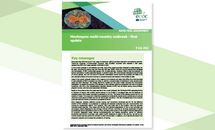Monkeypox multi-country outbreak - first update
Since early May 2022 and as of 7 July, cases of monkeypox (MPX) have been reported in non-endemic countries. Twenty-six European Union/European Economic Area (EU/EEA) countries have reported 4 908 cases, representing 65% of all cases reported worldwide in 2022.
Executive Summary
In the current outbreak in non-endemic countries, most of the cases have been detected in males between 18-50 years, and primarily among men who have sex with men (MSM). Particular sexual practices have facilitated the transmission of MPX among MSM groups with multiple partners. However, there is also the potential for further transmission in other population groups. In endemic areas, MPX virus has been detected in a broad range of animal species, and the occurrence of zoonotic transmission events cannot be excluded, but there is no documented evidence of human-to-animal or animal-to-human transmission in the EU/EEA to date.
Cases in the current outbreak present with a spectrum of symptoms and signs that differs from that described in past outbreaks of MPX in endemic countries. In addition, a small number of subclinical or even asymptomatic cases has been described. This finding should be verified and the public health relevance for transmission established. As regards the severity of the disease, in this outbreak cases have presented with mild to moderate symptoms, with only a few hospitalisations reported. Severity of MPX may be higher among young children, pregnant women, and immunocompromised individuals.
Based on the evidence from the cases reported in the current outbreak, the likelihood of MPX spreading further in networks of people with multiple sexual partners in the EU/EEA is considered high and the likelihood of spreading among the broader population is assessed as very low. The impact of the disease remains low for the majority of cases. The overall risk is therefore assessed as moderate for people having multiple sexual partners (including some groups of MSM) and low for the broader population. The risk of establishment of an enzootic cycle and spill-over events to humans is considered to be low.
Early diagnosis, isolation, effective contact tracing, and vaccination strategies are key for the effective control of this outbreak. It is essential to underpin all response measures with risk communication and community engagement efforts. Until recently, MPX was quite rare in the EU/EEA, with only sporadic imported cases reported. This, along with the fact that clinical presentations in the current outbreak are not typical, makes diagnosis by the average clinician difficult. Activities to increase awareness of health professionals across specialties should continue, providing information on the range of clinical presentations of currently diagnosed cases, testing recommendations and testing procedure, advice on infection prevention and control in primary care, public health measures in place in the country, as well as risk communication tips and advice for outreach in their communities. In addition, countries should review their diagnostic capacity and increase the availability of testing.
At this point, mass vaccination for MPX is not required nor recommended. Unless contact tracing can successfully identify a high proportion of infected contacts, mathematical modelling results indicate that targeted pre-exposure prophylaxis (PrEP) of individuals at high risk of exposure would be the most effective strategy to use vaccines to control the outbreak. Therefore, prioritising groups of MSM at higher risk of exposure, as well as front-line staff with a risk for occupational exposure, should be considered in developing vaccination strategies.
Modelling the efficient use of vaccines indicates that PrEP vaccination would be the most efficient strategy when there is less effective tracing. The modelling also suggests that post-exposure prophylaxis (PEP) vaccination of contacts would offer a marginally more efficient approach if there are both higher uptake levels and more effective tracing (as fewer vaccines would be needed for a relatively larger increase in the probability of outbreak control per vaccinated individual), while the absolute probability of outbreak control with PEP vaccination is still lower than with PrEP vaccination. In settings where higher vaccine uptake is expected, PEP vaccination of close contacts of cases should also be considered, or even ring vaccination. Among these, contacts with a high risk of developing severe disease, like children, pregnant women, and immunocompromised individuals, should be prioritised.
Targeted national vaccination programmes should be implemented within a framework of collaborative research and clinical trial protocols with standardised data collection tools for clinical and outcome data. Targeted health promotion interventions and community engagement are also critical to ensuring vaccine uptake and reaching out to those most at risk of exposure. Antivirals for the treatment of MPX should preferably be used in the framework of a clinical trial to obtain harmonised safety and efficacy data.
What is new in this update
This updated rapid risk assessment includes new information on the different clinical picture of MPX cases in the ongoing outbreak. It includes novel insights from a stochastic mathematical model developed collaboratively by ECDC and the European Health Emergency preparedness and Response Authority (HERA) to assess vaccination strategies as outbreak response measures. It also contains references to all the recently produced technical documents on contact tracing and risk communication and community engagement developed in collaboration between ECDC and the World Health Organization (WHO) Regional Office for Europe and civil society organisations.
Download







